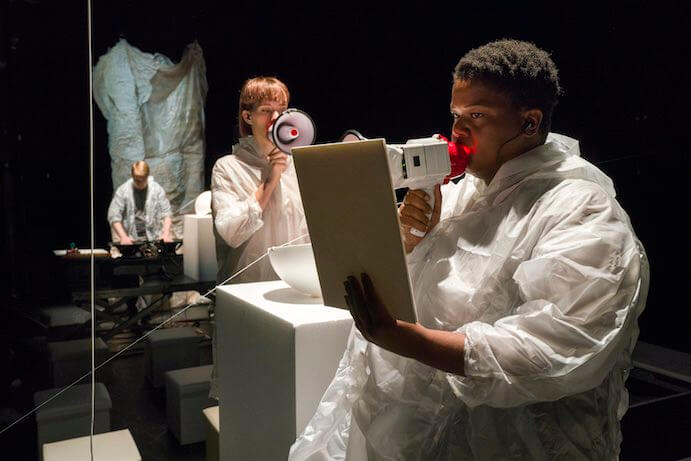“I feel like I’m inside a glacier,” my friend commented to me as we made our way out of Ashley and Adam Fure’s opera The Force of Things, which was performed as part of Lincoln Center’s Mostly Mozart Festival in August. During the immersive multimedia experience, the audience moved through a collection of sculptures that shifted and swayed thanks to vibrations from speakers emitting sound at a volume so low as to be inaudible to humans. The unidentifiable objects comprising architect Adam Fure’s structural component loomed ominously above our heads. The white shapelessness of it all brought to mind concepts of purity and afterlife and “goodness,” especially in combination with the piercing bright lights and eerie shadows of Nicholas Houfek’s lighting design. These visuals were gradually layered with vocal and instrumental sounds produced in real time by musicians from the International Contemporary Ensemble (ICE).
Ashley Fure states that with The Force of Things, she tried to sonify the ecological anxiety that looms larger than whatever “illusion of stasis” we experience within our day-to-day existences. The opera’s sound world, and the rates of change within it, are meant to mirror the effects of climate change. Even though global warming might feel imperceptible on a day-to-day basis, it is clearly having fast-paced and drastic impacts: even though we can’t always hear it, the inevitability of ecological disaster surrounds us just as the “inaudible” speakers do. The environment co-authored by the Fure siblings cultivates a mode of listening attuned to the agency of objects and elements: as Ashley puts it, “matter in this piece is an active, vital force with its own trajectories and transformations.”

As we filed from the first room (in which we all stood underneath Adam’s suspended structures) to the next (where we sat on stools positioned between more hanging structures, speakers, and platforms hosting the ICE musicians), the sounds flickered and fluttered towards our ears from different directions. Throughout the hour-long opera, rattles and rumbles were scattered across time and space. Amplified human breaths, rasped into megaphones by Alice Teyssier and Lucy Dhegrae, overlapped with the sounds of Adam’s objects-turned-musical-instruments, as well as objects and traditional musical instruments played by musicians from ICE. These included a saxophone, a bassoon, and an array of bowed and struck objects expertly sounded by percussionists Ross Karre, Levy Lorenzo, and Dustin Donahue.
The musicians eventually wandered off their platforms and up an incline into the shadows. The sounds of amplified breathing and whirring continued to mingle with mysterious pinging sounds emanating from the speakers. Although I could not quite draw the connection with climate change, the sounds that were produced were intricate and imaginative, and I found myself holding my breath in anticipation of each new rumble or scrape. Eventually, high sustained tones grew longer and louder, gradually encroaching upon our auditory space as the musicians inched down the incline, closer and closer to the audience. This tedious middle section dragged on, only ever-so-incrementally growing louder and most insistent. By the end of the opera, as the sound world had become more piercing and urgent, a couple of audience-goers put their hands over their ears.
The Force of Things was composed over the course of two years, and was first performed at the Darmstädter Ferienkurse (Darmstadt Summer Course for New Music) in August 2016. According to data compiled by Fure herself, only 7% of pieces premiered at Darmstadt between 1946 and 2014 were composed by women. Fure is a relentless voice of reason within a male-dominated sphere, calling out the sexism of a German review of The Force of Things that was titled “Flying Vaginas.”
From my vantage point, there was nothing about the opera that felt explicitly gendered or sexualized (although I would buy a ticket for a “flying vagina” opera in a heartbeat). The sounds we were enveloped by seemed to creep across my consciousness like the sensation of déjà vu, like dim memories or half-remembered dreams. The Force of Things seeks to aestheticize ecological precarity in a post-human sound world distributed across and beyond the limits of human audibility and understability.

Still, I have to wonder what Fure’s ultimate goal is. She describes herself as “driven by a desire to tune our focus toward a rate of change and a scope of alteration at odds with the scale of human life.” Yet the folks who could afford tickets to the Mostly Mozart Festival performance seemed to be mostly well-off liberals who probably recycle, bring reusable canvas tote bags to the grocery store, and have already internalized the dire urgency of global warming. Fure is not the first composer to concern herself with ecological crisis; John Luther Adams has done so perhaps most effectively. An outdoor work like Adams’ Sila can be heard and experienced by hundreds of listeners regardless of income. The 2014 premiere, which was free and open to the public, fostered a more thought-provoking and inclusive listening experience than the closed-off, painstaking restraint of The Force of Things.
Even if the composer might not have “succeeded” fully in her mission to bring attention to climate change, her opera is a triumph in other ways. In focusing on sound as a material force rather than solely an aural one, The Force of Things is more than a musical metaphor for ecological anxiety. The work disassembles ableist notions of sound and listening that rely on the concept of sound as an “event” rather than overlapping interactions and intermateriality. The Fure siblings have created an environment for sound and listening in which aural perception occurs through multi-sensory immersion rather than passive reception. Rethinking the typical compositional impulse for control allows for a reformulation of sound itself. In this way, Ashley Fure defies conventions of directional listening and allows for a wholly new and innovative experience.
























